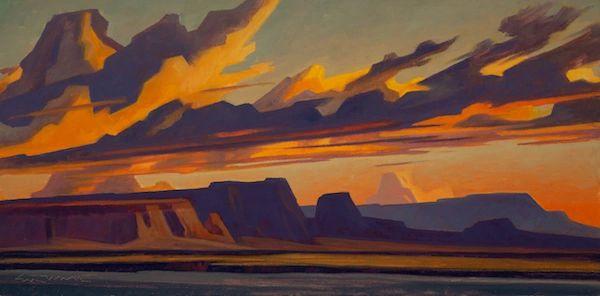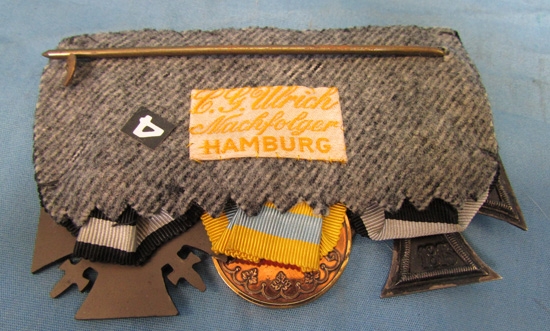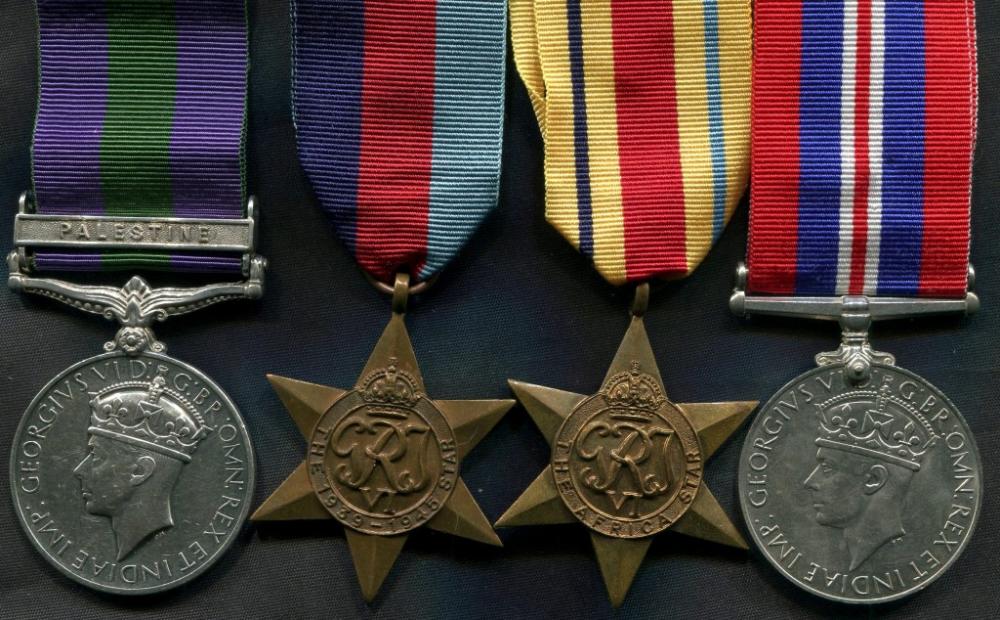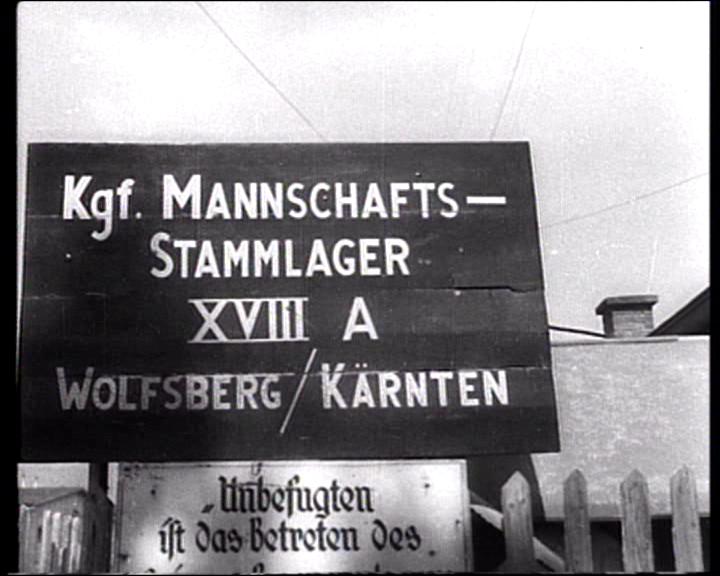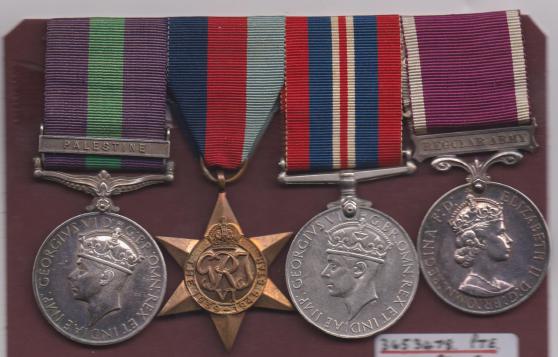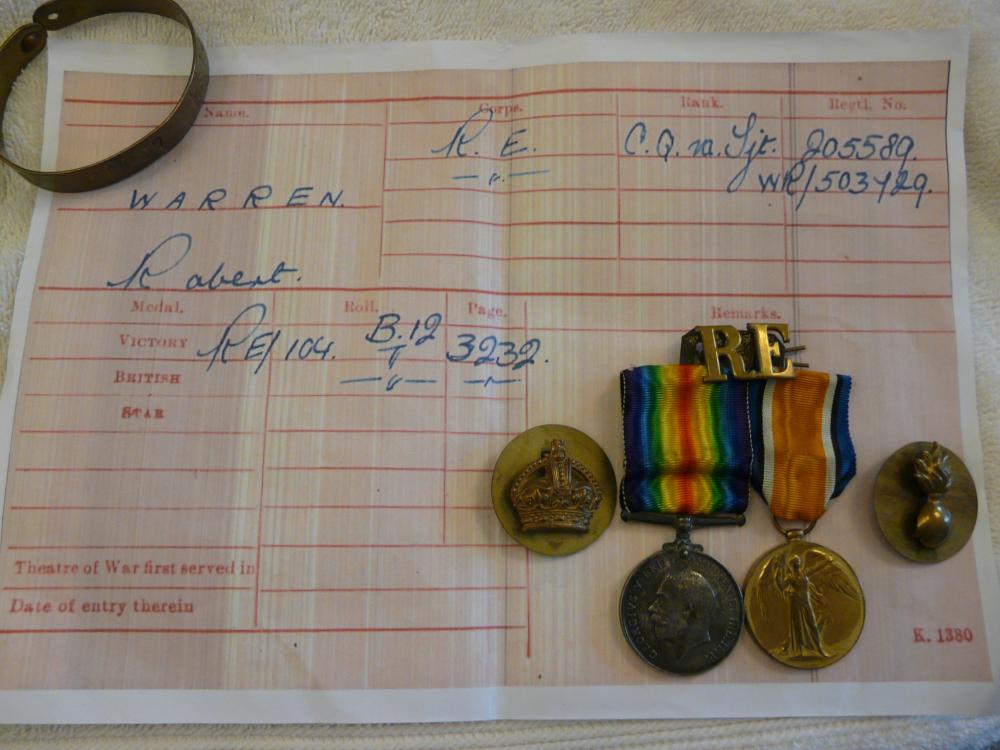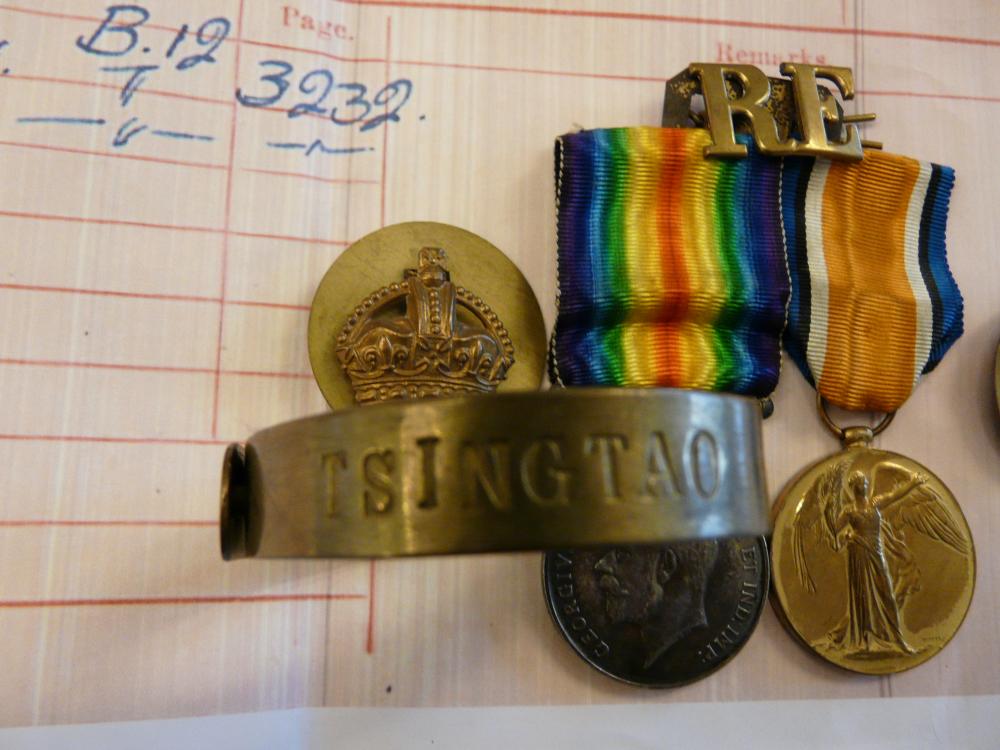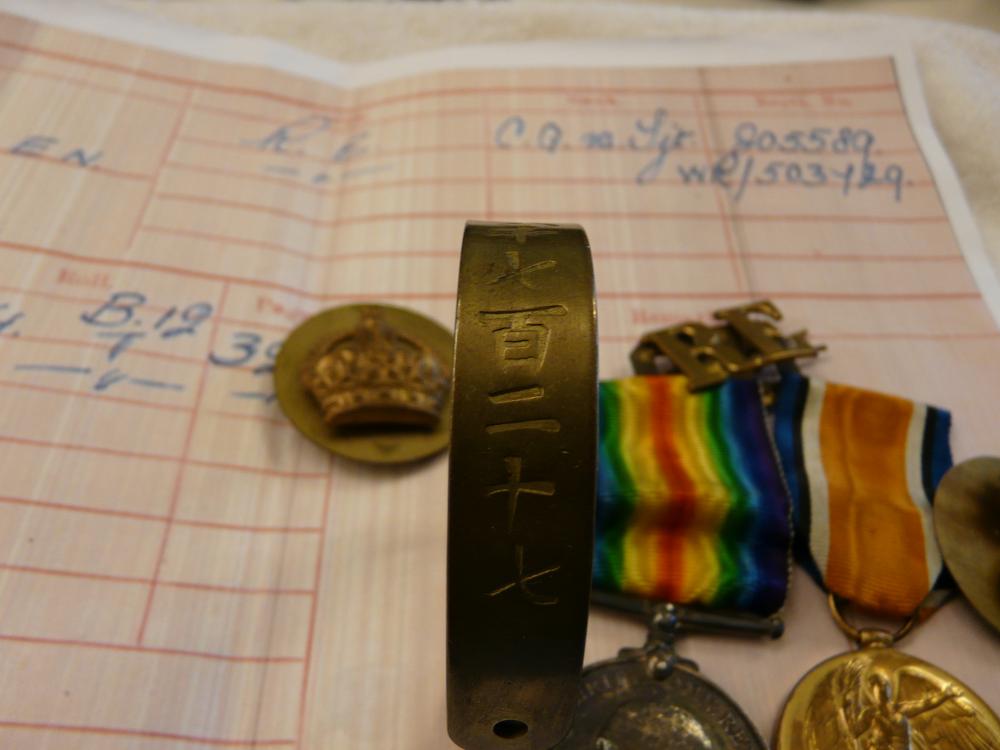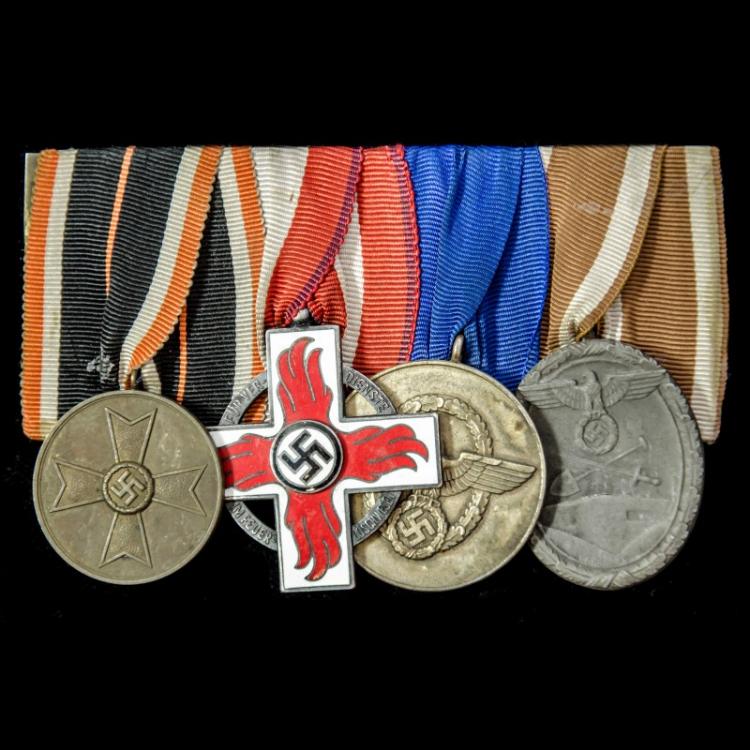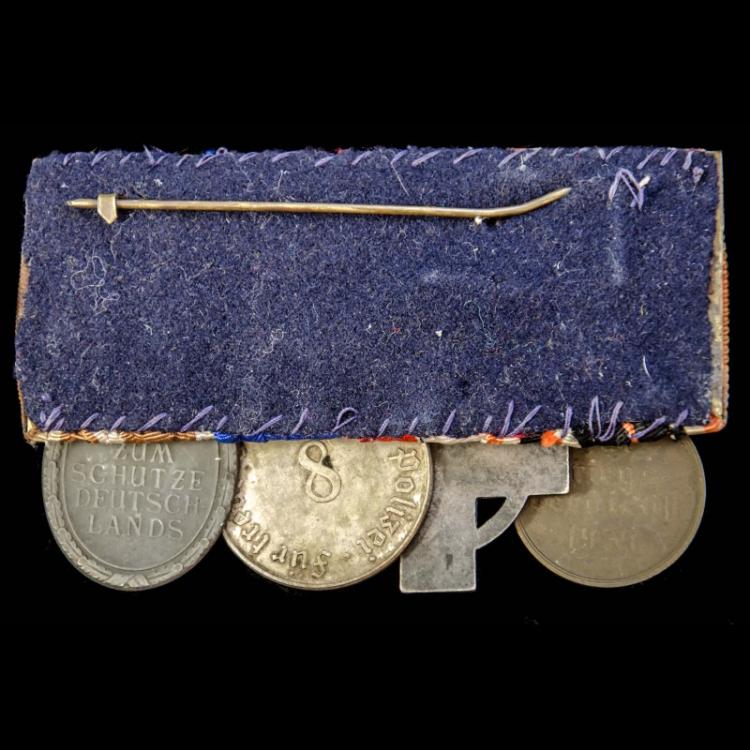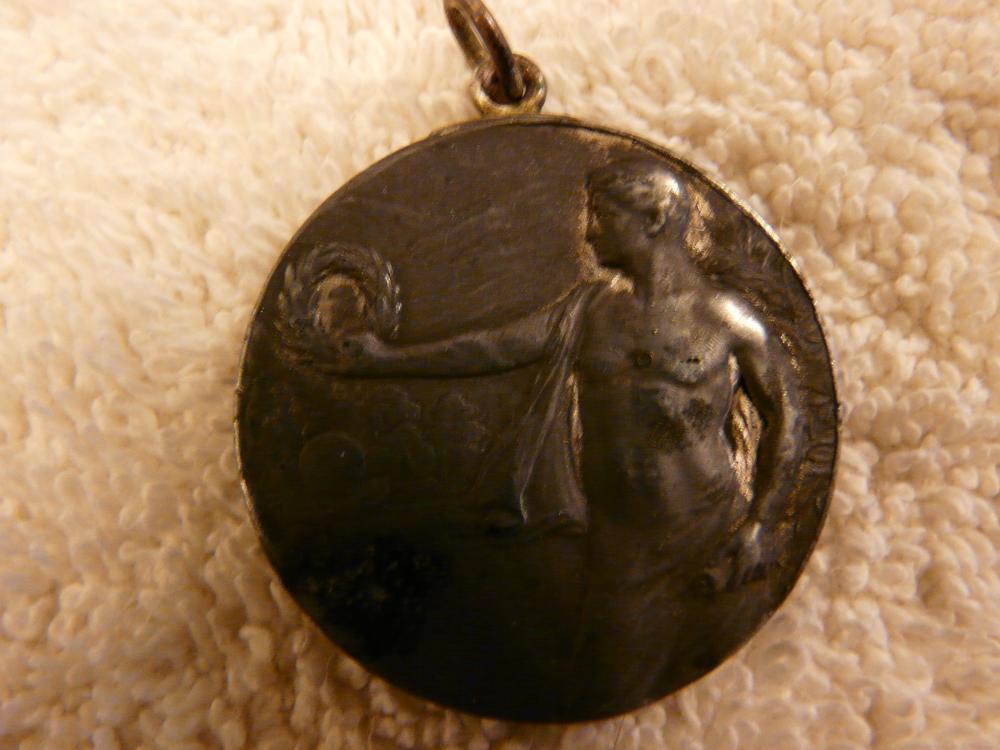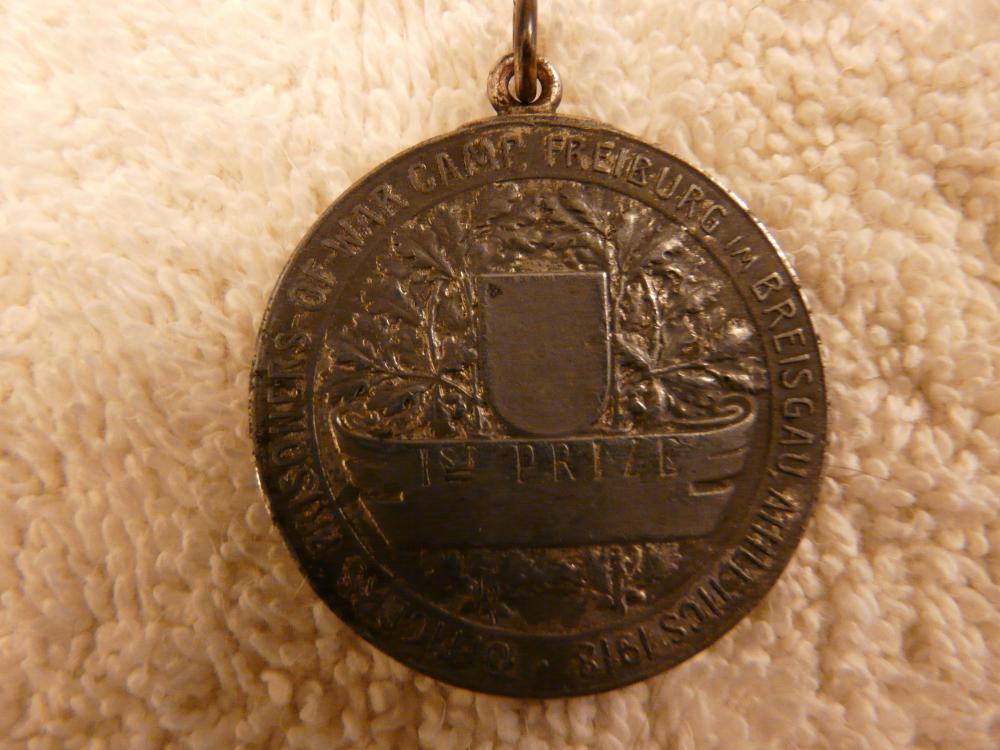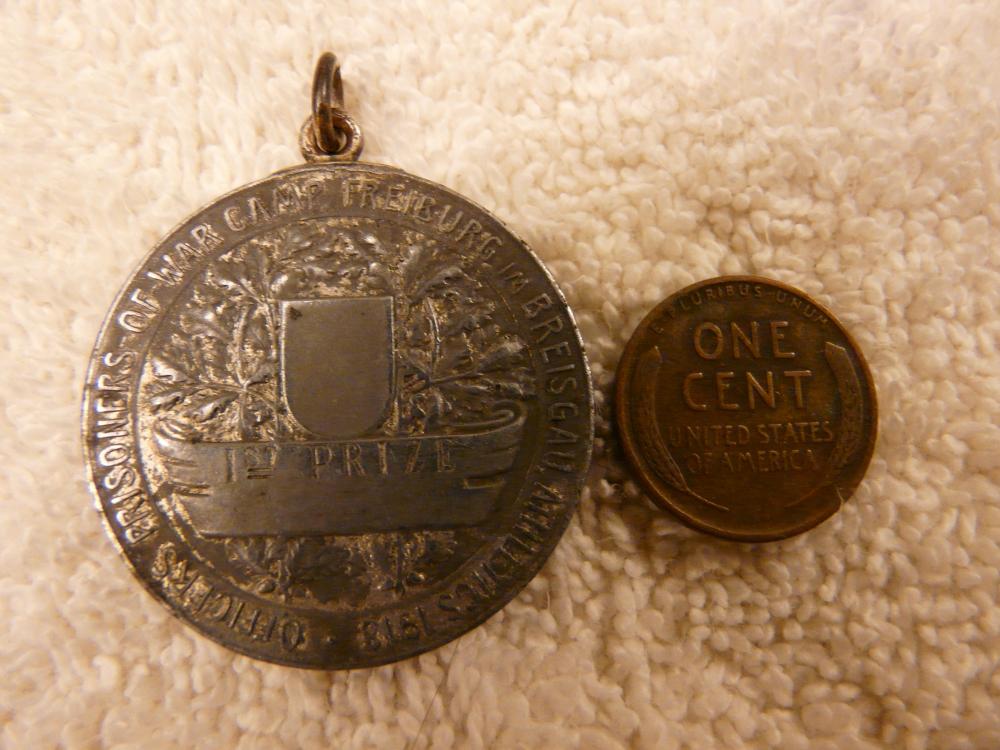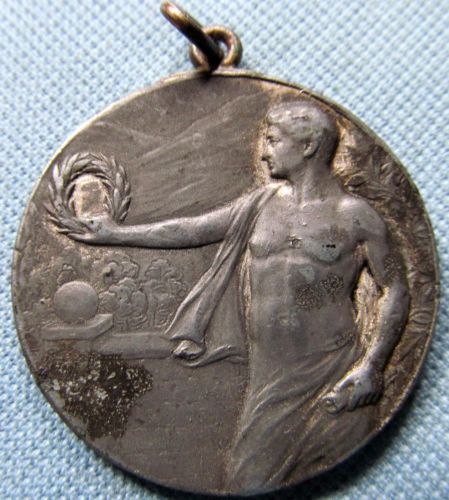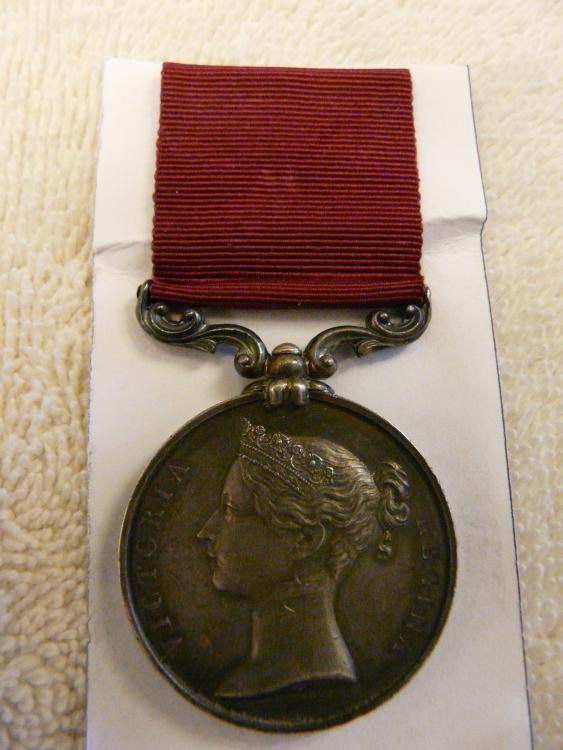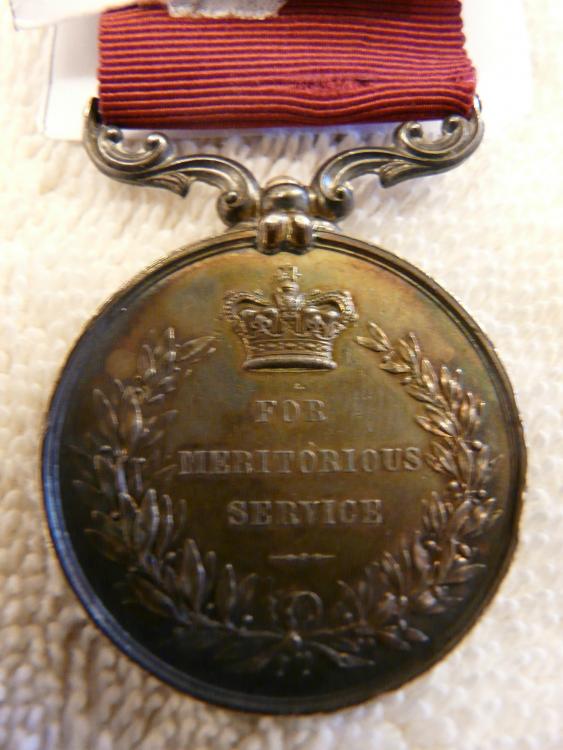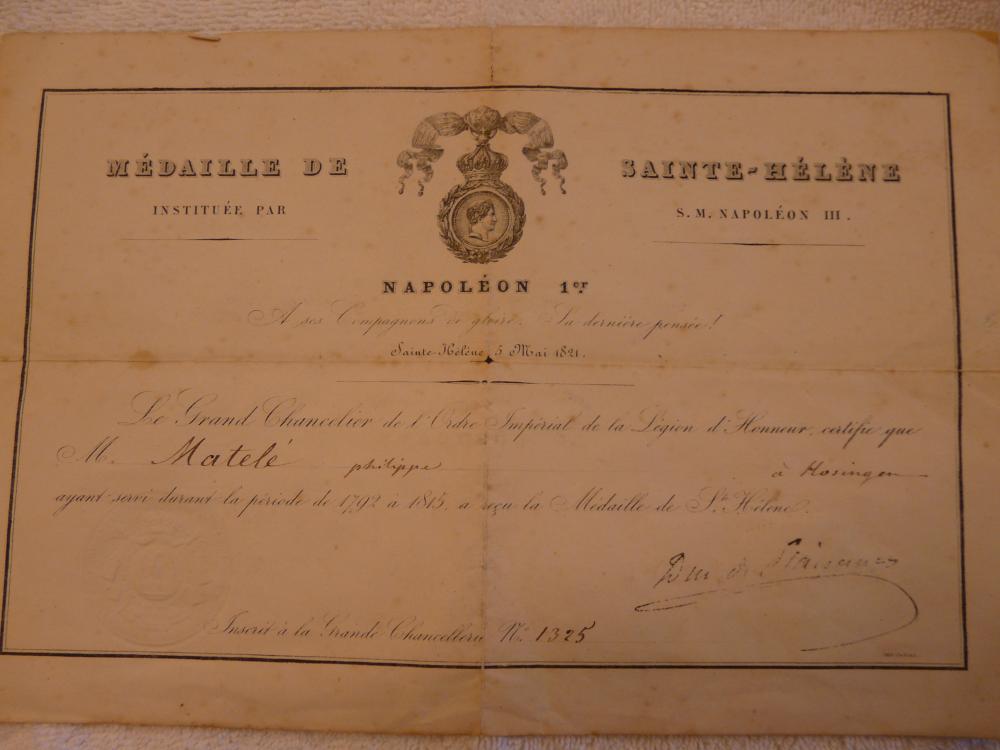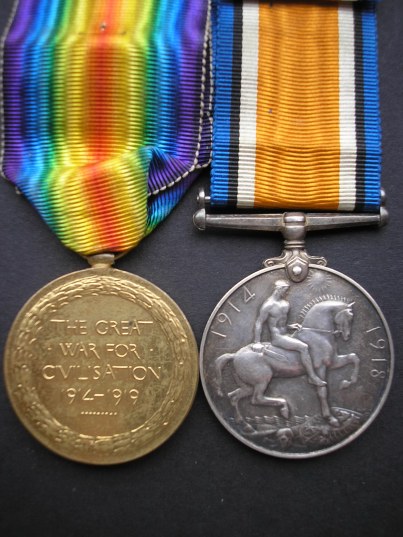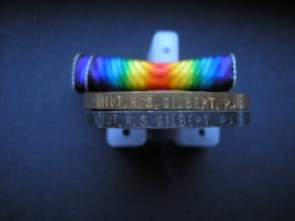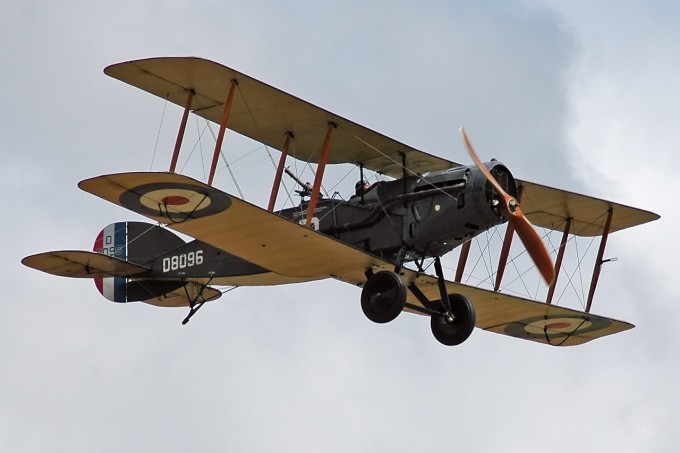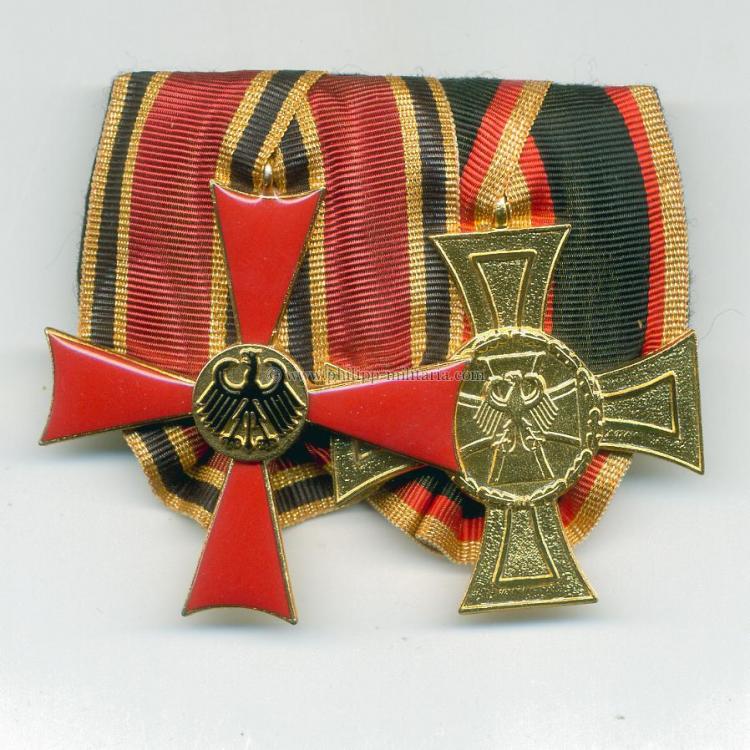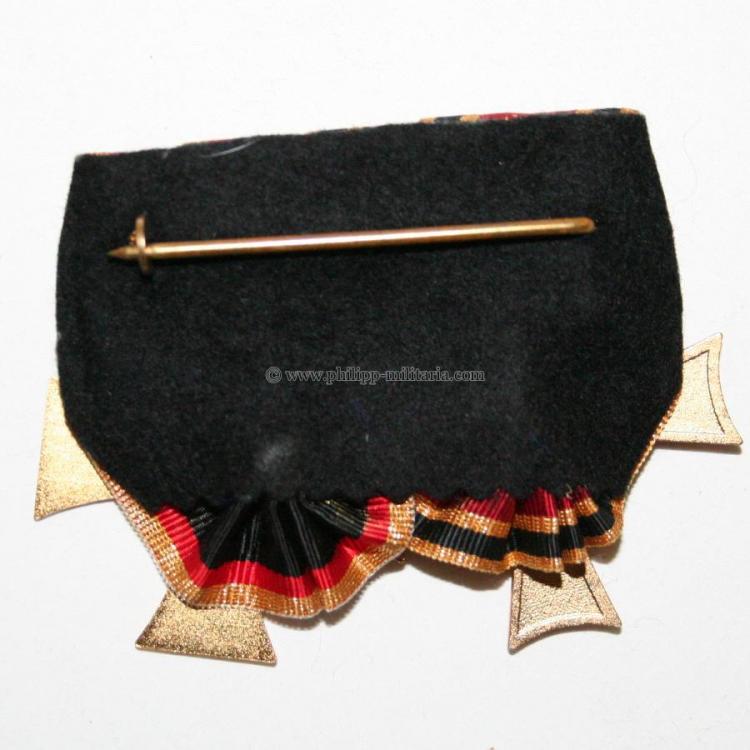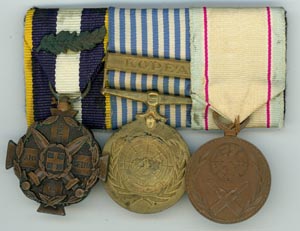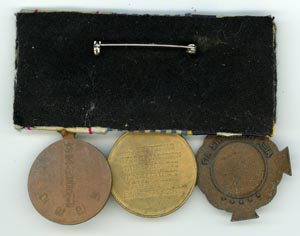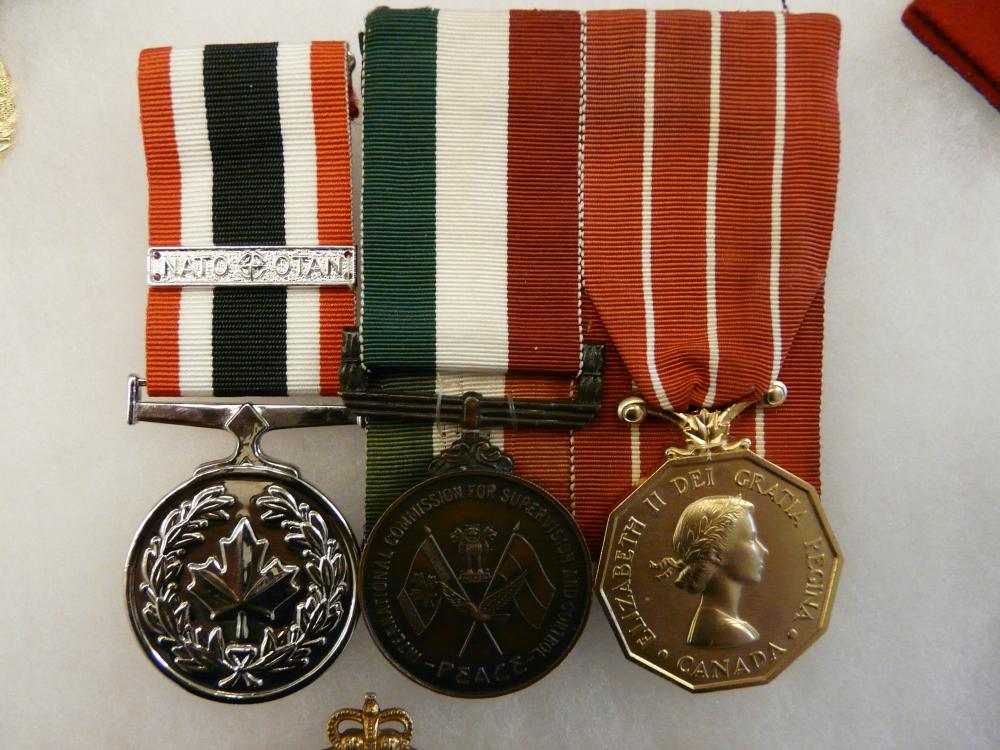-
Posts
1,802 -
Joined
-
Last visited
-
Days Won
10
Content Type
Profiles
Forums
Blogs
Gallery
Events
Store
Everything posted by azyeoman
-
Some people find groups to corps less desirable, but they're not always so... General Service Medal GVI clasp Palestine - T/5772464 Dvr T Currie RAS 1939/45 Star, Africa Star, War Medal - unnamed as issued Here is the nominal roll for Stalag XVIIIA with Dvr. T. Currie PoW # 3320 - http://www.stalag18a.org/rollcallC.html Info on group and some from PoW repatriation report. Thomas William Currie was born 28th May 1919 and attested for the Royal Army Service Corps on 6 May 1937. His home address is recorded as 35 Hamilton Road, Golders Green, London. Serving with 2/3rd Cavalry Field Ambulance, 7th Armored Division, probably as an Ambulance Driver, he was taken Prisoner of War in Greece 29th April 1941. On 27th April German tanks entered Athens, on 28th April 1941 some 43,000 British and Polish troops of the Expeditionary Force re-embarked at Nauplia, Monemvasia and Kalamata. The Royal Navy sent 6 Cruisers, 19 Destroyers and a great number of small transports to carry out the evacuation. In this disastrous campaign the Expeditionary Force lost 12,712 men including 9,000 taken prisoner by the Germans, and the whole of its heavy equipment. The evacuation of Greece codenamed Operation Demon was successful. Held at first at Stalag XVIIIA in Wolfsburg, Austria he stayed in the camp until 16th June 1941 moving to Liezen, Austria, he was employed in Quarry work until 9th September 1941, next to Hieflau, Austria where he worked on the railways until 9th September 1943 then finally to Leoben, Austria where he was again employed in Quarry work. For more information on Stalag XVIIIA see: http://www.wartimememories.co.uk/pow/stalag18a.html and http://www.data-wales.co.uk/stalag1.htm Currie recalls the Austrian people were always very friendly to British PoWs and in his repatriation report dated 29th May 1945 records – ‘On the day of the capitulation, the camp gates were opened and we were free men. We stayed in the camp awaiting contact officers, after waiting one week our Company Man of Confidence (sic) gave the order that every one had to find their own transport. With the help of Her Joseph Stein Brugger, I managed to take six parties of four men to the English troops in Judenberg by private car. On the final trip, myself and six others were stopped by the Russian troops and were refused permission to cross the border, consequently we had to wait until 20th May, at which time the Russians allowed us to cross to Wein Kichen (sic) and contact our troops, the 2nd Battalion Leicestershire Regiment and finally we arrived at Naples on 29th May 1945. The car was handed over to Captain Howie, Leicester Regiment.’ And info from the Australian War Memorial with photo below: Photo II: Leoben, Austria. 1944. Group portrait of prisoners of war (POWs) held at Leoben, south of Hieflau, dressed in their newly issued clothing and boots (the first and only issue in three and a half years). Left to right: back row: A. Cooper, E. Webb, E. Bailey, T. Holt, W. Spellacy and W. Clarke. Centre Row: E. Collinson, J. Gordon, Alec Robertson, Royal Army Service Corps (RASC), E. Rowse, VX20950 Sergeant Driver Ewen Gilchrist Halls Headquarters 1 Australian Corps, W. Currie*, E. Burridge, F. Bickestaffe, H. Stainer and H. Martin. Front row: H. De Meiers, R. Simpson, T. Jones, W. Gardner, unknown, and J. Repen. Halls and Robertson along with twenty other POWs were transferred here from Hieflau to build up members at a Limestone quarry. * Note there is a Currie in row 2, but the initial is "W" and not "T". Photos III & IV: Hieflau, Austria. 1943-06. Informal group portrait of Australian, British and New Zealand prisoners of war (POWs) relaxing outside a lookout and warning station situated next to Mount Tamischbacturm after transporting timber and cement for repairs and maintenance of the station. The station was to warn of avalanches in winter and rock falls in summer. The shirtless man to the left of the door is VX20950 Sergeant (Sgt) Driver Ewen Gilchrist Halls who served with HQ 1 Australian Corps and became a POW on 28 April 1941. Hieflau was a small hamlet which housed 120 POWs, 117 Britons, 2 Australians and a New Zealander, all captured in Greece and Crete in 1941, who worked on the important railway junction in the Gesause ravine.
-
Sgt. W.H. PRICE GSM (GVI) with PALESTINE clasp: 3653478 PTE W H PRICE .BORD R. 1939-45 STAR WAR MEDAL ARMY LSGC (EII): REGULAR ARMY: 3653478 SGT W H PRICE M.P.S.C. Pte. William Herbert Price was captured at Tournai, Belgium on 21 May 1940 when he was with the 1st Bn. Border Regt. He was slightly wounded. He was held at the following camps: STALAG 344, XXB, XXA, XIB, VIIIB. His PoW report states he escaped from Camp XXA in Poland and was captured by the German Police. It also states he tried to sabotage railway signal wires, but was unsuccessful. His address was 6 St. Lukes Ave. in Lowton, Lancs. For more info: http://www.bbc.co.uk/history/ww2peopleswar/stories/21/a2312821.shtml Palestine The Battalion was recalled to England from Palestine in April 1939, where it had been stationed for three years with the 14th Infantry Brigade and had performed with such distinction that its loss was keenly felt by both the Arab and Jewish communities, as well as the local British forces. Lt-Colonel Lay DSO was presented with a scimitar by Chief Faris Irshaid who said, "You gave us some hard knocks at the beginning, but we asked for it and we have no complaints. We are glad to know we part as friends. This sword is not a symbol of war, but a gift in friendship". Writing to the Colonel of the Border Regiment, the commander of the Brigade said "I don't suppose any Battalion has earned the same admiration from everyone in Palestine as they have done. In fighting they have invariably been outstanding, whether in action on a big scale, as in the early days of the Rebellion when big gangs were encountered, or in the smaller actions and raids by platoons or small parties under junior leaders. Lay has thrown his heart and soul into the business of restoring order here and has controlled his area in a way that no one else has approached. I can hardly express what I owe to him personally and to your Regiment as a whole for setting an example, which others have sought to imitate, and so raising the level of the whole Brigade. Your Regiment showed me there was little that could not be done and done well." France Based at Mandora Barracks in Aldershot the 1st Border received a new commander, Lt-Colonel Chambers MC, and became a part of the 4th Infantry Brigade, which was subsequently incorporated into the 2nd Infantry Division. As part of the British Expeditionary Force the Division departed for France in late September, where the Battalion was moved to Orchies, near Lille, and they spent the following month digging trenches and other defenses. Billeted in such places as barns with little in the way of local entertainment, morale took a dive with the onset of a cold and wet winter and the necessity for the continuation of their work in such miserable conditions. The 'Phoney War' produced no trace of enemy activity on the Belgian border, and it became customary for one British Brigade at a time to take its turn on the Maginot Line defenses, and so having celebrated Christmas Day a week early, where as the Battalion's tradition dictated the officers served the other ranks, the 4th Brigade made its way forward on the 24th December. Life on the front line was cold and a little surreal considering the state of war. Patrols were organized to scout across the frontier, but there was seldom contact with the enemy and instead both sides took it in turns to bombard each other with artillery, without a great deal of enthusiasm or intent. Suffering no losses, the 1st Border withdrew from the Maginot Line on the 13th January 1940 and at the end of the month was relocated near the frontier at Rumegies. Throughout February the Battalion was once more engaged in the task of digging defenses and constructing pill boxes, and continued to do so until the 25th April when orders came for their transfer to the 125th Infantry Brigade, serving with the 42nd Division. Following a disagreement with his new Brigadier at the beginning of May, Lt-Colonel Chambers was relieved of his command and replaced by Lt-Colonel Hennessey DSO MC. On the 10th May the Germans invaded neutral Belgium. At this time most of the Battalion were keeping watch over the crucial bridges linking France and Belgium at Comines, Deulemont, and Warneton, while B Company guarded the Bondue aerodrome to the north of Lille. The British Expeditionary Force advanced 60 miles to the River Dyle to counter the invasion, with the Belgian Army and French 1st and 7th Armies on their flanks. The 42nd Division concentrated on the River Escaut, but a withdrawal of the whole force was announced on the 15th May when a defense proved to be unworkable. This retreat was further encouraged by the enemy breaching the French lines to the south and a subsequent thrust to the sea to trap the Allied armies. At 15:00 on the 17th May, the 1st Border began the march to fresh positions at Don, covering a distance of 25 miles to reach it by dawn on the following morning, but two days later the whole Brigade was called to Froyennes, to the north of Tournai, to guard a section of the River Escaut. The 1st Border secured a line than spanned 3,500 yards, with B Company in the middle, A on the left, C on the right, and D in reserve. It was a large area for one Battalion to hold and the distances involved made communication between the companies difficult, with Battalion HQ forced to locate itself 3,000 yards behind the front line. On 20 May the Germans launched a heavy attack against the Battalion, with strong mortar fire directed on the forward positions and troops infiltrating between A, B, and C companies. Though the position was unsteady, all held their ground while British artillery subdued the mortars harassing C Company and then lay a bombardment across the whole area. Enemy shelling began in earnest at dawn on the following day, and an infantry assault succeeded in getting behind both B and C Company, and though some elements still offered resistance most of their forward positions had been overrun. The Carrier Platoon and two of D Company's Platoons were sent forward to assist, but to little effect. Later in the morning telephone communications had completely broken down due to the lines being cut by the shelling, and all dialogue was now reliant on runners. With the situation refusing to improve, one of the Brigade's other Battalion's, the 1/6th Lancashire Fusiliers joined the 1st Border's HQ Company and moved forward to reclaim ground lost without meeting opposition. Leaving one company behind to act in a reserve capacity for the Lancashire Fusiliers, the Battalion was withdrawn that night. On the 22nd May the Germans crossed the Escaut with an attack across the whole of the 42nd Division's front, forcing them to withdraw to a second line of defense on the Franco-Belgian border. The 1st Border were initially in reserve, but moved with the Brigade during the night to positions at Lezennes, south-east of Lille. Here they occupied a 2,000 yard wide front and held these positions whilst under attack until the 26th May when they were ordered to depart for Barques, near Carvin, to beat back a German breakthrough that had occurred there. However upon their arrival it was discovered that the situation had been dealt with, and so the Battalion marched once more to defend a 4,000-yard wide area near Loos on the Deule Canal, west of Lille. The following two days saw little in the way of enemy interference, bar a few confrontations with patrols, however the surrender of Belgium left the entire British Expeditionary Force and their French comrades highly vulnerable to an attack on their left flank. The bridges over the Deule were destroyed and the order was given for all units to make for Dunkirk. While not seriously challenged, the position of the 1st Border was highly precarious on the afternoon of the 28th as they were quite alone and German tanks were reported to have overtaken them on either side. There was a danger that the Battalion would become cut off, but luckily they were able to commandeer the lorries of a Bridging Section, and having laid waste to the equipment inside them the 1st Border made their way to the rendezvous at Neuve Eglise. Confusion and chaos reigned on the road to Dunkirk, and numerous parties from the Battalion, including HQ Company, lost their way from the main body. Approximately 80 of these stumbled into the 5th Border Battalion and were taken under their wing, and in dribs and drabs others found their way to the beaches. The Battalion itself arrived during the early hours of the 29th May and spent all of that day waiting on the beaches until their turn came to be evacuated by one of the little ships that had rushed to their aid. Partial timeline: 16 May 1940 (night) Tournai is heavily bombed for the first time. Most civilians have already fled the town. 19 May 1940 Tournai is ablaze due to the bombing. There are few civilian firefighters left to extinguish the fires. 125th Brigade re-joins the 42nd Division. 1st Border takes over some of the positions of 5th Border. 5th Battalion Headquarters moves to La Marmite (Tournai). 42nd Division is part of the rearguard for the withdrawal. The French 1st Army, plus the British 1st and 2nd Corps fall back and pass over the Escaut. They are pursued by the enemy. 20 May 1940 The canal bridges are blown before the enemy arrives. The Germans proceed to shell the defensive positions. 21 May 1940 The Germans break into the positions held by 1st Border. A counter-attack by 125th Brigade recovers control of the river banks of the Escaut. 5th Border comes under heavy fire, especially in and around its HQ. 22 May 1940 The Germans attack along the whole front occupied by 42nd Division. Evening - 42nd Division is ordered to disengage and withdraw. 1st Border initially falls back to Lezennes, close to the southern suburbs of Lille. 5th Border falls back on Cysoing (S.E. of Lille), covered by the carrier platoon under the command of 2nd Lt. J.R. Musgrave. D, B and C Companies are placed in forward positions. A Company is placed in reserve. 5th Border stays in the Cysoing area for 3 days. 22 May 1940 - 25 May 1940 During this time the 5th Border positions are frequently shelled. 24 May (night) - the left flank held by 5th Border spots a concentration of enemy troops in a sunken road and calls in defensive fire from the whole battalion. The planned enemy attack is repelled. 25 May (morning) - enemy snipers are spotted in a nearby house and haystack. Artillery rounds destroy the house and Captain T.P. Hetherington of C Company sets the haystack ablaze. Elsewhere, German armored forces break through in the Ardennes and take Amiens, Abbeville and Boulogne and Calais. The B.E.F. is cut off from its bases and in danger of being cut off from the sea. The B.E.F. makes its way towards the coast and Dunkirk. 26 May 1940 - 27 May 1940 26 May (night) - 5th Border moves initially to Lesquin (south of Lille). C and D Companies are initially left at Cysoing to cover the withdrawal. These 2 companies move directly to Le Bizet (north of Armentières). HQ Company becomes separated passing through Armentières and just avoids contact with German armored tanks. The battalion links up at Le Bizet on 27 May. At Le Bizet about 80 other ranks from 1st Border who were separated from their own unit link up with 5th Border.
-
Thanks Brett. Yes, the Cameroon campaign was most interesting. As for the German apology; it's about time! If you want to read about that genocide, the first of the 20th Century, read The Kaiser's Holocaust. A very well written book that shows the Germans were doing horrible atrocities long before 1933. I find the WWI African campaigns most interesting, don't you? To find a PoW group for one of them is quite unusual to put it mildly.
-
Here is a very unusual, rare actually, confirmed WWI PoW for Africa. 1914-15 Star (Lieut. S. Staffs Regt) British War Medal Victory Medal (Capt.) Medals are named to: M. J. Parker, and mounted as worn. Very unusual qualifying area for the 1914-15 Star, Caprivi Zipfel, Rhodesia. Maskell John Parker was born at Upper Norwood, Surrey on 1 July 1888 & was educated at Dulwich College. The recipient’s Medal Index Card shows entry into War Zone 4(e) Caprivi Zipfel Rhodesia and that he applied for his medals from, Transvaal, South Africa. Captain M. J. Parker, Sierra Leone Battalion, West African Frontier Force, was wounded in action and taken prisoner by the Germans. When he recovered consciousness he found a German native soldier pulling his broken leg, three others pointing their rifles within a few inches of his face, while another held a bayonet over his left shoulder, and a sixth stripped him of his equipment. A European then approached, and, drawing a small operating knife about 6in long, said, "Do you want to live or die? It is quite easy "to relieve people's sufferings with this." Captain Parker said he had only a broken leg, and did not wish to die. One of the soldiers then addressed the European, saying, "Why do you not kill this white man; you killed the other white men ". A German dispenser then came up and made arrangements to set the broken leg; meanwhile the other European moved over to where a couple of British native soldiers were lying wounded. The European bent down and stabbed both men in the throat, one after another, killing them on the spot. He then came round in front of Captain Parker and cleaned his knife on his puttee. Such are the crimes that disgraced German arms throughout the Cameroons campaign, and they go far to explain why the Germans have failed so consistently as colonists. The instances here quoted from but a small portion of German crimes committed in the Cameroons.—Ajax. (From: King & Country Chronicle, Vol. XII, Issue 1141, 26 November 1918, Page 2.) THE HEEL OF THE HUN: GERMANS AND NATIVES. (Passed by the Press Bureau.—Per favour secretary Royal Colonial Institute.) The conduct of the Germans towards natives during the Cameroons campaign was barbarous in the extreme, and more in keeping with the traditions of some savage tribe than the customs of a great European Power. The evidence collected from natives by the French and British during their advance, and in many instances corroborated by photographs, shows that the Germans indulged in wholesale bloodshed, accompanied by deeds of the most callous cruelty. The following are but a few instances of their methods: A native named Andreas Jengelli, who had fled from the Germans at Mbonjo, made the following report to Captain Cwynne Howell, of the British General Staff at Duala "There are about 10 Germans with 100 native soldiers in Mbonjo. They are shooting natives and burning the countryside. They have killed about 30 native men and women. They say that the British may conquer the country, but they will find no inhabitants left." This threat, so typical of the modern German; our enemy did his best to make good; with the result that the natives ran into the bush whenever German troops approached, hut sought protection from the British and French, whom they recognised as friends. General Dobell, who was in command of the Allied forces, makes the following comment upon the conduct of the Germans .—"On some occasions it is said that no Europeans were present during the enactment of the brutalities described, but sufficient evidence is here available to show that German Europeans encouraged such acts by personally cutting the throats of wounded British soldiers with knives, firing on peaceful inhabitants to terrorise them, and shooting natives without trial. In such circumstances as these it is extremely difficult to obtain the names of the Germans concerned, especially as the natives, as a rule, do not know or take an interest in the names of the Europeans whom they see on these occasions." In this connection Mr K. V. Elphinstone, M.A., of the Nigerian Civil Government, Chief Political Officer with the British forces in the Cameroons, writes:—"lt should be borne in mind that the civilians killed by the Germans are the natives of a country under their protection, whom they had ruled for many years. The murders were not committed by an invading army; in fact, owing to the treatment meted out it was to the invading army the wretched natives fled for protection. They very soon summed, up the difference of treatment by the Germans and the Allied forces." The headman of Bwelelo reported: "Some people came running into my town from Ngori, shouting that a white man had killed two men. All the people began to run away. I remained in my house looking out. I saw some German soldiers come; they came up to about fifty yards. I then saw a white man coming on a horse behind. I know him; his name is Meinhardt. He shouted in German for the headman. I got out of the window and hid in the bush. During the night I saw the houses burning, and I heard shots when I first ran out. Next morning I went to Bonaberi and reported to the officer. I went back to the village the same day; then I found a great many houses burnt. We found Lobe Penda alive, shot in the right upper arm (he died the same day when we were taking him to Bonaberi). We found Ndja Njanga with his throat cut; he had been tied by the body, arms and forehead to a plantain. We found Ekwe Wanga shot dead outside his burnt house- Kolo Sofo was shot in the foot; he is alive now." Elong Ntoko, of Bonberi Ba Susa, reported:—"Bony, a Malimba man, came and told us all to go to Susa, as the Germans were coming. We started away at once. Before we got away we saw many German soldiers coming. They began firing at us. We all ran away. We came to Susa railway station and lay down behind the English troops. The Germans came, but were driven off. In the evening I went out and found the body of my brother behind a house in the village. He had been shot in the back." This is the experience of Ngoio Ngeki, of Kake:—"lt happened when there was a big fight at Susa. I went with my brother to Kake to get food. We had got inside Kake by my brother's house. He was picking plantains; I was quite close. Suddenly he called out, 'Nglo, l am caught!' I saw two German - soldiers kill him with a bayonet. I ran away to Susa. The English came out and fought the Germans at Kake. I buried my brother the same day as the Germans ran away." M J Parker PoW.webarchive
-
I've been wanting to find a civilian who was captured and held by the Japanese for a long time. This recipient's group consists of a photo of him at a wedding, but sadly it's impossible to tell if he is the groom or the best man. At any rate, there is his BWM and Victory named to him and oddly on the wrong ribbons. One of the most important items is the brass wrist band with Tsingtao on it as well as some Kanji. Qm Sgt. Robert Warren served in the RE during WWI and at the outbreak of WWII was working as an engineer in Tsingtao. He was captured and held prisoner there for the duration of the war. More photos of Warren's group and in particular his bracelet.
-
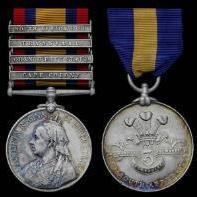
German State War Merit Medal Medal Bar
azyeoman replied to JBeltram's topic in State, Civil Awards & Decorations
-

My Prisoner of War Collection
azyeoman replied to POWCollector's topic in Great Britain: Orders, Gallantry, Campaign Medals
Congratulations Rob! Great group and write up. Thank you for sharing your research; so nice to have at least one named medal. -
An interesting WWI Recreational Training/Sports Medal 34mm and 14.8gms in Zinc. There is an example of this in the National Army Museum in London, which is described as follows: Recreational Training/sporting activities kept prisoners of war physically fit, staved off boredom and reminded men of their loyalty and duty to the Army. This medal was awarded to Lieutenant A Fry of the 4th Australian Pioneer Battalion when he was incarcerated at Freiburg-im-Breisgau prisoner-of-war camp Germany. By the outbreak of the First World War the Army had fully embraced athletics as a means of 'recreational training'. This might include 'fun' events like sack and obstacle races, as well as traditional track and field sports. Sports medal for athletics, 1918 NAM. 1994-08-132
-

A very very sad WW1 Victory medal
azyeoman replied to dante's topic in Great Britain: Orders, Gallantry, Campaign Medals
What a great story; what a great medal. Congratulations! I'd try my best to find one of his paintings. Thank you for sharing! -

Paper worth more than metal: St. Helene brevets
azyeoman replied to azyeoman's topic in Napoleonic Wars
Thank you for the explanation. What a terrific group! -

My Prisoner of War Collection
azyeoman replied to POWCollector's topic in Great Britain: Orders, Gallantry, Campaign Medals
Great write up Rob! Thank you for sharing this. I love the photo; smiling when captured; that stiff upper British lip! Great! -

Paper worth more than metal: St. Helene brevets
azyeoman replied to azyeoman's topic in Napoleonic Wars
Very nice! What is the number on the Brevet. It looks to be quite low, is it? What is the second medal? The Association of Brothers in Arms Bruxelles? What do you know about Col. Schelten? Was he Flemish and served under Napoleon I? -
Conceivably the rarest PoW medal in the collection. A Victorian MSM (990 of this type issued) to 822 Segt. James Weir 44th Foot. Weir was severely wounded on 23 November 1841 at Cabul and then taken hostage by Mohammed Akbar Khan on 29 December 1841. He was a PoW for nine months and liberated on 26 September 1842. There were approximately 110 hostages of which some were women and children. It is not known how many medals were issed to those who were captured and survived. Weir survived the retreat from the 6th to the 13th of January 1842 because he had been wounded and was a PoW. Weir was born in 1809 in Minto, Dunbartonshire, Scotland and was a weaver by trade. He attested (under age - age 17) on 18 February 1826 in Killmensrock, Ayr. He served for one year and 318 days as an underage private. He enlisted again on 1 January 1829 and served as a private until 10 April 1834. He became a Sargeant on 11 April 1834 and served as such until 24 July 1849: a total of 22 years and 158 days of which 17 years and 250 days were in the East Indies. He character was "very good" and he was discharged as unfit for service. at Parkland Barracks. He was awarded an annuity with his MSM. It is relatively easy to find medals to PoWs for the Napoleonic and Crimean Wars and even more so for the 2nd Anglo-Boer War. WWI and WWII are exceptionally easy and even Korean PoW medals are not rare. But medals to soldiers captured by non-western troops were normally killed and as such this medal is exceptionally rare.
-

Paper worth more than metal: St. Helene brevets
azyeoman replied to azyeoman's topic in Napoleonic Wars
A scarce brevet to Philippe Matele of Hosingen (1325), which is now a suburb of Luxemburg. At the time Luxemburg was under French control and part of the Department des Forets. Luxembourgers were subject to conscription in the French Army and had been since 1798. Each Luxembourg village and town had to meet a quota, which meant that between 20K and 25K men were conscripted into the French Army. It is thought that about 760 St. Helene Medals were issued to veterans of Napoleon's army. From on-line data, it appears that the Luxembourgers were issed brevets in the 1300 range. St. Helene brevets are scarce and this one, a brevet to a foreign soldier and veteran, is quite rare. -

My Prisoner of War Collection
azyeoman replied to POWCollector's topic in Great Britain: Orders, Gallantry, Campaign Medals
Hi Rob, A nice addition. It is indeed possible to unit it with its companions. I've united four groups of medals and one plaque over 40 years. So good luck with that. Your collections just keeps on getting better and better. Thank you for doing all the wonderful research and sharing that; after all, it's the man behind the medal that counts, eh? I look forward to your next post! -
A fine RAF MID pair to Lt. Gilbert LIEUT. R.S. GILBERT, R.A.F. Obs. 22 Sqd., (Bristol Fighter B.F.2b) Prisoner of War shot down by Lt. H. Viebig. Gilbert was M.I.D. as a PoW. His British War & Victory Medals with Mention in Despatches (M.I.D.) are named to: LIEUT. R.S. GILBERT, R.A.F. His is listed in the London Gazette on 16 December 1919 “…for gallantry whilst Prisoners of War in escaping or attempting to escape from captivity, or for valuable services rendered in the Prison Camps of the enemy.” He was wrongly gazetted as Lieut. ROBERT Stredwick Gilbert, R.A.F. There is no Robert Stredwick in the R.A.F. only ROLAND Stredwick Gilbert, with the rank of Lieut. His debrief PoW report states Pilot & Obs. "Shot down 11.10.17 by Lt. Hans Viebig when escort to bombing raid, attacked by 6 E.A. piercing petrol tanks & the engine cut out. Sent to Karlsruhe." Service Record, address Wandsworth, S.W.18. Officers Service Papers both as Roland Stredwick Gilbert. 22 Sqd. RAF The squadron was formed at Fort Grange, Gosport on 1 September 1915 from a nucleus of men and equipment split off from 13 Squadron. The squadron trained on a variety of aircraft types, including the Royal Aircraft Factory BE.2c, the Maurice Farman Shorthorn, the Bleriot XI and the Curtiss JN-3. It received its intended operational type, the Royal Aircraft Factory FE.2b in February 1916, passing 14 BE.2s to 33 Squadron. The squadron moved to France on 1 April 1916, and soon settled down to carrying out reconnaissance missions over the front lines. It flew fighter patrols during the Battle of the Somme in July 1916, in addition to its normal reconnaissance and photography duties in support of the army. One notable casualty during the Somme was Auberon Herbert, 9th Baron Lucas, the former Liberal politician and cabinet minister, who was wounded when attacked by German fighter aircraft on 3 November 1916, and died of his wounds the same day. From July 1917, the squadron started to replace its FE.2s with faster and more capable Bristol F.2 Fighters also known as the 'Brisfit', receiving its full complement of 18 aircraft by 24 August. This was in time to allow the squadron to take part in the Battle of the Menin Road Ridge in September 1917. The squadron was heavily deployed during the German Spring Offensive of 1918, and was forced to change bases due to the German advance, and later, as the Allies drove the Germans out of France in the Hundred Days Offensive, changed bases to keep up with the Allied advances. The squadron moved to Spich, near Cologne in Germany as part of the British Army of Occupation in March 1919, leaving for home at the end of August that year. After a period as a cadre unit (without aircraft) at RAF Ford, the squadron formally disbanded on 31 December 1919. By the time it was demobilized, it had had 27 flying aces within its ranks, both pilots and observers, For information on Oberst Hans Viebig go to: http://www.theaerodrome.com/aces/germany/viebig.php
-

Bundesrepublik The new "Iron Cross"
azyeoman replied to webr55's topic in Germany: Post 1945: Bundesrepublik & DDR
-
Thank you. I'm familiar with the sites and this publication of which I have the complete photocopy. I am hoping that there might be even more information available. :-)
-
I'm going to resurrect this by asking again for any input. Thanks in advance.
-

The Korean War is NOT forgotten
azyeoman replied to azyeoman's topic in Modern Campaigns and Conflicts
-
Hi Brian,
It's good to hear from you again. I know what you mean about some collectors pontificating and being aggressive as well as others trying to buy the medals from you. I've only sold one medal to a man who ended up presenting to the original recipient. Recently I have been approached by another regarding a new Zealand Vietnam pair, and yet another whose grandfather's uncle's medals grace my collection. Both were gracious, but I was firm that I would not sell, but if I did, if contact them and they don't know me other than by my moniker Azyeoman.
I am looking forward to reading your about your new acquisitions!
All the best, John
-
John
Yes maybe a misake on my side to use my name on Forums.
Will be on Night Shift in a few weeks time and will hopefully manage to add one or two to the album.
Your collection blows me away...and I was looking earlier at your amazing German collection. Trully awesome to say the least. I have a very small collection of German medals, we do not see too many out here.
Regards
Brian
-

